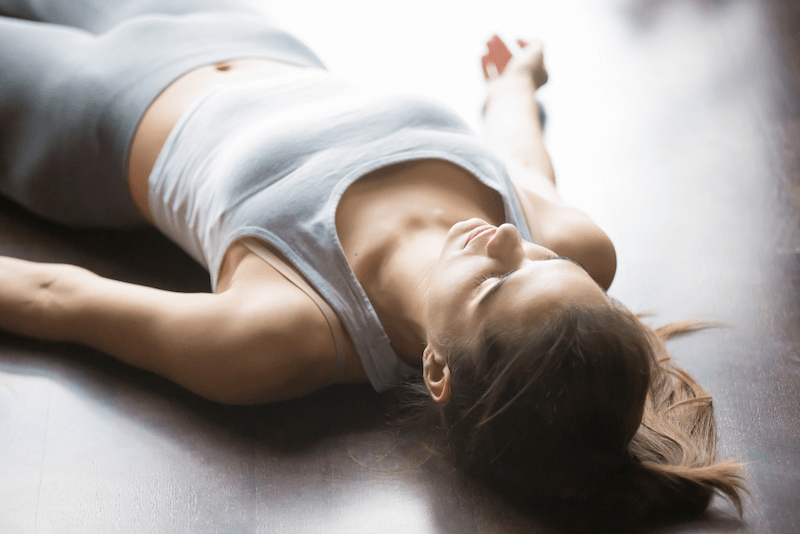If you’re reading this, you may be feeling the effects of stress and are seeking some relief! This blog will briefly describe the way our bodies – and our gut – respond to stress, and give you some tools to improve your resilience and overall wellbeing. We will discuss the best types of relaxation techniques for stress reduction.
Humans are not well adapted to the modern world

Every day, we encounter minor mental stressors that our ancestors didn’t have to deal with. They had to deal with the physical threat of fighting predators, while we have to deal with things like long work-weeks, financial worries, adapting to life during a pandemic… These things don’t compare when it comes to life and death, but unfortunately for us, our bodies react the same way to both types of situations.
Our bodies have an automatic response to stress, which our brains perceive as a psychological threat. The brain triggers a cascade of events within the body called the stress response, which way back in the day was meant to ensure our survival. Today, the stress response may be triggered multiple times over the course of the day, keeping our cortisol levels high and leaving us in a maladaptive, sympathetic nervous system state.
The stress that so many of us feel on a daily basis can actually be both physically and mentally harmful. Stress has a HUGE impact on digestion and gut health, and luckily for us, there are steps we can take in order to take back control over our gut health in the midst of a stressful life.
The relaxation techniques listed below can be practiced regularly to give you better control over your reactions to stress. But first, let’s discuss the impact stress has on your gut health.
How does stress impact the gut?
For digestion to function normally, we must be in a relaxed, unstressed state where the parasympathetic branch of the autonomic nervous system is in control. Whenever we experience stress, the automatic stress response activates the opposing branch of the autonomic nervous system – the sympathetic branch.
The sympathetic branch inhibits digestive functions, because they are not essential for immediate survival. This can lead to many digestive problems, especially when stress becomes a recurrent aspect of your daily life – when stress becomes chronic.
So what impact does stress have on the gut? Some symptoms (that you may be quite familiar with) that are commonly experienced due to stress can include diarrhea, constipation, nausea, indigestion, abdominal pain, and heartburn.

Enough bad news… let’s get to the good news! Reducing the stress in our lives is not only possible; it is relatively simple to do. Here are some stress reduction and relaxation techniques that you can add to your daily life today!
Relaxation Technique #1: Vagus Nerve Exercises
The vagus nerve is part of the parasympathetic autonomic nervous system – the branch that dominates only when we’re relaxed. This branch is nicknamed the “rest and digest” branch because digestive processes can only function under a relaxed, parasympathetic state.
Your vagus nerve is connected to every organ in your torso except the adrenal glands, which pump out the stress hormones when you are stressed.
The vagus nerve has many impacts on digestive health, and stimulating this nerve is important for improving resilience in the face of stress. So how do we stimulate this nerve to make it function better?
The vagus nerve runs through the muscles in the back of your throat. Vibrations on these muscles can activate the nerve, which over time can help you bounce back from stress more easily.
Here are a couple simple things you can do to stimulate the nerve and improve your vagal tone:
- Gargle warm salt water (until your eyes start watering!)
- Sing at the top of your lungs! Or hum loudly.
- Use cold water for 1 minute at the end of your showers

Luckily, practicing vagus nerve stimulation at home can be so simple! Both of these techniques are easy to do and can be added to your daily regimen immediately, so why not try them out today?
Relaxation Technique #2: Practice Mindfulness
Mindfulness involves simply being present in the moment and paying attention to any bodily sensations. We are predisposed to have our minds wander since we are constantly stimulated in our daily lives. Mindfulness techniques center you to notice your current physical and mental state without judgment. The continued practice of bringing attention to the present moment and how you are connecting with your surroundings is clinically shown to reduce stress and negative mental states.

A common mindfulness method is to complete a body scan. To do this, you can be lying down, sitting, or standing. Just close your eyes, breathe slowly, and focus on how your body feels starting from your feet upward, or from your head downward. Focus on how your clothes feel on your body, how certain body parts feel touching each other, and any pressure felt from the ground or the chair. Doing this even just a couple times can help reduce stress and induce a feeling of peace.
Relaxation Technique #3: Yoga Nidra
Yoga nidra, also known as “Yogic Sleep,” is a form of pre-bedtime guided meditation that puts you in a very relaxed state. For most people, this form of meditation is much easier to accomplish than sitting still and trying to “clear your mind.” Practicing yoga nidra over time can lead to benefits such as better sleep, reduced stress, and improved wellbeing.
Yoga nidra involves lying down on a yoga mat (or even your mattress), setting a sankalpa (intention), and simply following what the guided meditation says. Some practices are 5 minutes, others can be an hour or longer. There are many audio guides of varying lengths available online that can easily be followed at home, so this practice is accessible to everyone!

Yoga nidra is an easy way to reduce stress, relieve tension and pain, and connect with yourself on a deeper level. Practicing yoga nidra right before you go to sleep can clear the mind and allow yourself to tap into your subconscious self to reach your goals and intentions.
Relaxation Technique #4: Deep Breathing Exercises
One of the best relaxation techniques involves something that we usually do without any thought. Breathing is essential to human life, and is key in both the mindfulness and in yoga nidra practices mentioned above.
The diaphragm is the key muscle that is used in relaxed breathing states. However, many people breathe using their accessory respiratory muscles rather than the diaphragm.
To test whether you’re prone to dysfunctional breathing, place one hand on your chest and the other on your belly. Take a few deep breaths in, and pay attention to which hand is moving. Your belly should be the area that expands when you inhale. If your chest is expanding more than your belly, this is a sign that you might be in a sympathetic state, under stress.
Slow, deep breathing using your diaphragm improves efficiency within the lungs. Clinical studies also show that deep breathing plays a huge role in our cardiovascular health and helps to decrease blood pressure. It can also promote higher heart rate variability (HRV), which is a sign of high vagal tone.
Studies suggest that practicing deep breathing exercises regularly for 3 months or longer can shift your autonomic nervous system to parasympathetic dominance – this means that deep breathing can modulate your stress response so that you are more resilient in the face of stress!

Deep breathing exercises have been practiced for centuries, especially in Eastern cultures. Western cultures are just now realizing the advantages of a more holistic approach to wellness, even though many practices have been around for hundreds of years. In yoga, breathing is called “pranayama.” One variation of pranayama is alternate nostril breathing.
How to do Alternate Nostril Breathing:
- Sit in an upright, relaxed position and close your eyes. Place one hand with your palm facing upwards on top of your knee.
- With your other hand, raise your pointer and middle fingers and lightly place them in between your eyebrows. Your ring and pinky fingers should cover one nostril, and your thumb covers the other nostril. Do not exert any hard pressure to your nose or forehead.
- Exhale through your right nostril while holding the left nostril shut.
- Inhale through your right nostril, then shut the right nostril and release the left nostril.
- Exhale through the left nostril, while keeping the right nostril closed.
- Inhale through the left nostril, then close the left nostril and exhale through the right nostril. This step completes one cycle of alternate nostril breathing.
- Continue these steps for as long as needed to relax the mind.
- Always inhale through the nostril you just exhaled through.

Another deep breathing exercise that can be used to calm your nerves is called 4×4 breathing (aka square/box breathing).
How to do 4×4 Breathing:
- Sit or lie down in a comfortable, relaxed position and close your eyes. Release any tension from your body.
- Inhale through your nose for 4 seconds
- Hold your breath for 4 seconds.
- Exhale through your mouth for 4 seconds.
- Hold your breath for 4 seconds.
- Repeat this cycle as many times as you want over the course of a few minutes until you feel a sense of calm.
Since stress negatively impacts our health, it is important for us to take back control in whatever ways we can. As you can see, none of these relaxation techniques are very difficult, so it is easy to get started today! Pick whichever relaxation technique works best for you, or combine multiple techniques and you may begin to feel less stressed within a short period of time.

Still feeling stressed over your gut health?
Schedule your appointment today to help you get to the root cause of the problem, so you can start living your best life!

Sources:
https://breathe.ersjournals.com/content/13/4/298
https://www.sciencedirect.com/science/article/abs/pii/S1566070201002673
https://www.sciencedirect.com/topics/medicine-and-dentistry/heart-rate-variability




